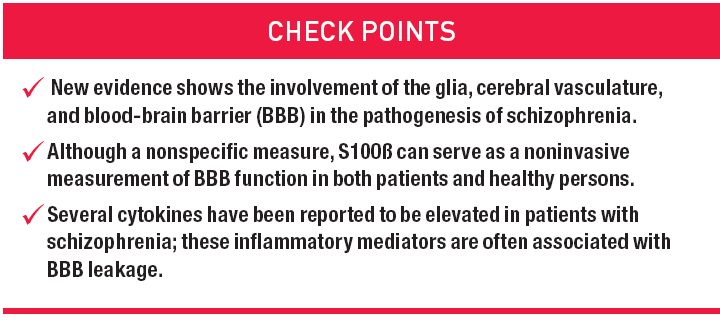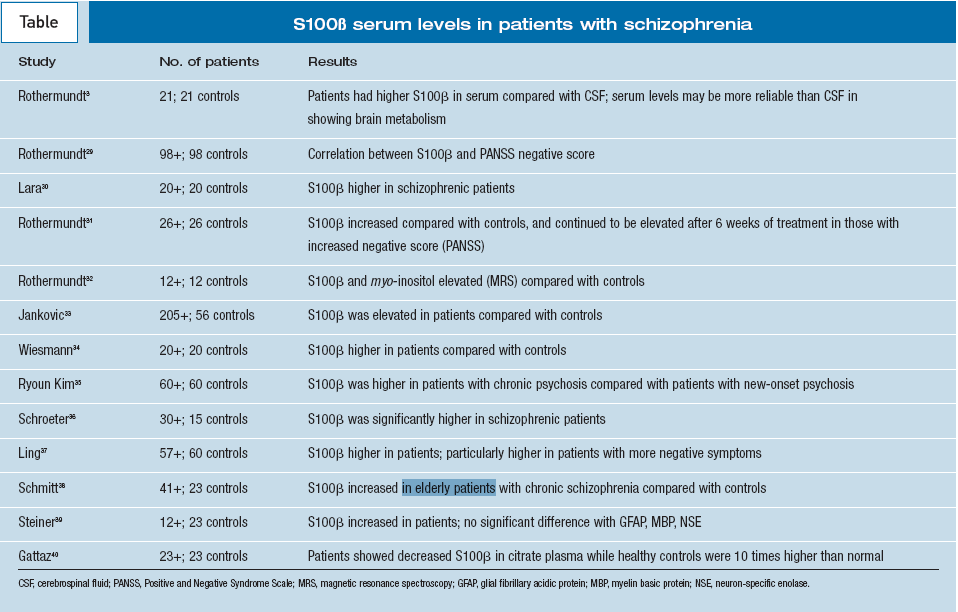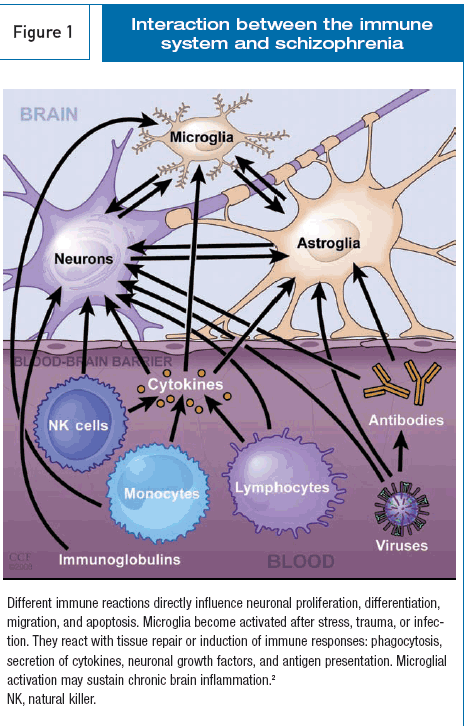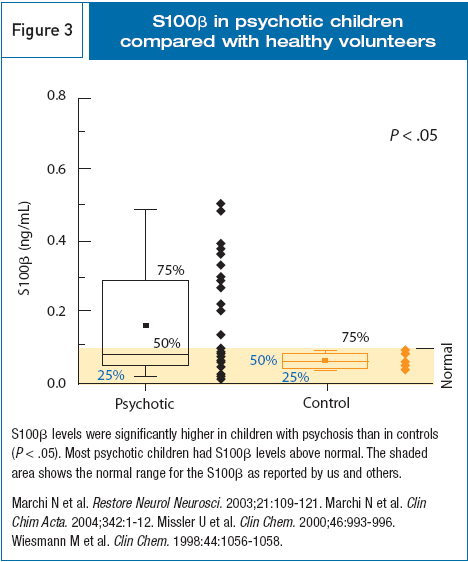Publication
Article
Psychiatric Times
Inflammation, Psychosis, and the Brain
Author(s):
When the solution to a clinical or scientific puzzle eludes us for more than a century, as with schizophrenia, we need new methods to examine the pathology. If we want to make an impact on the disease we must shift research paradigms and focus on the early detection, early intervention, and new avenues of treatment that address different symptoms of schizophrenia.
When the solution to a clinical or scientific puzzle eludes us for more than a century, as with schizophrenia, we need new methods to examine the pathology. If we want to make an impact on the disease we must shift research paradigms and focus on the early detection, early intervention, and new avenues of treatment that address different symptoms of schizophrenia. Immunological and blood-brain barrier (BBB) abnormalities in patients with psychosis have been repeatedly noted. Hundreds of studies of schizophrenic illness in adults have documented immunological abnormalities in these patients, and an increasing number of studies have shown a link between S100b, a marker of BBB function, and schizophrenic illness (Table).1-3

In looking at the possible causes of schizophrenia, earlier studies focused on neurons. Increasing evidence now suggests that the glia, cerebral vasculature, and the BBB may be involved. Two postmortem studies reported activated glial cells in a subgroup of patients with schizophrenia.4,5 Using the marker PK11195 to label glial cells in patients with psychosis, Hirsch6 found activation throughout the cortex using positron emission tomographic accentuation in the frontal lobes. Here we present evidence linking inflammation, immunological abnormalities, BBB disruption, and neurological disorders.
BBB in health and disease
The BBB is a physical and metabolic barrier that regulates and protects the brain. This barrier is composed of tight junctions between endothelial cells in CNS vessels that restrict the passage of solutes. Several lines of evidence have pointed to a link between CNS problems-such as psychiatric disorders and inflammation-that occur in response to pathogens. Impairment of the BBB may be the consequence of immunopathogenic mechanisms.7
Little is known about the microvascular endothelial cells that form the BBB. Technical difficulties and lack of specific markers for BBB endothelial cells have made this research difficult. However, with recent advances in methodological techniques, it is becoming possible to identify important characteristics of BBB endothelial cells.

Integrity of the BBB reduces entry of immunocompetent cells and antibodies and is necessary for the immune system to attack infectious agents. A highly specialized tight endothelium isolates the brain from immune surveillance and allows only a few mononuclear cells, activated T cells, and macrophages to migrate into the CNS.8
During inflammation, extensive leukocyte migration occurs at the BBB.9 Both endothelial cells and astrocytes act as antigen-presenting cells to facilitate entry of T lymphocytes and antibodies. The BBB itself plays an active role in mediating the neuro-immune response.
Cytokines, or cellular hormones, include neurotrophins, neuropoietic factors, interleukin (IL)-1 and IL-6, interferons (IFNs), colony-stimulating factors, growth factors, and thymic hormones that are released following stress. Perivascular macrophages, microglial cells, astrocytes, and cerebral endothelial cells can produce cyto-kines on activation.10 Cytokines influence the transport of compounds into the brain by altering the permeability of the BBB. In vitro studies reveal that the administration of IL-1, IL-6, tumor necrosis factor (TNF)-a, and IFN-g increases endothelial permeability.11-14 TNF-a can induce the production of matrix metalloproteinases-in particular gelatinase B-that attack the basal lamina macromolecule-like type 4 collagen that surrounds the brain microvessels. Modulation of adhesion molecules may promote leukocyte adhesion to the cerebral endothelium and permit the migration of lymphocytes across the BBB via a transcellular route (Figure 1).

Serum and cerebrospinal fluid S100b protein, inflammation, and schizophrenia
There is increasing interest in the brain-specific protein S100b and its physiological roles and behavior in various neuropathological conditions. Levels of S100b, a small astrocytic calcium-binding protein, are increased in some neurological conditions, such as brain trauma, ischemia, epilepsy, and brain tumors. Increased serum levels of S100b help rule out BBB disruption as reliably as contrast-enhanced MRI and can be identified in seconds to minutes after BBB disruption. Elevated serum levels of S100b also predict the presence of neoplasms in the CNS. S100b thus serves as a noninvasive measurement of BBB function in patients and healthy persons.
S100b levels are elevated in first-episode psychosis, chronic schizophrenia, and acute psychosis (Table). In 14 studies that evaluated 399 adults with schizophrenia and 389 controls, S100b concentrations were above normal: average levels were 0.158 ng/mL in patients who have schizophrenia and 0.02 ng/mL in healthy controls. In a larger sample, Rothermundt and colleagues3 demonstrated the association of negative symptoms of schizophrenia with continuously elevated S100b for 24 weeks after an acute episode. Findings indicate that patients with initially elevated S100b concentrations show significantly slower improvement.
Monocytosis in patients with schizophrenia
Monocytosis has been reported in 5 studies. In their original observations of catatonia, Bruce and Peebles15 reported 12 cases of adolescents with psychosis and leukocytosis-particularly monocytosis. Zorrilla and colleagues16 reported monocytosis in symptomatic schizophrenic patients. Nikkila and associates17 compared cerebrospinal fluid samples obtained from schizophrenic patients and controls. The proportion of mononuclear/macrophages was signficantly higher in samples taken from patients who had schizophrenia. Wilke and coworkers18 detected a statistically significant increase in leukocyte numbers, particularly monocytes (P < .05), in patients compared with controls. Kowalski and colleagues19 demonstrated activation of monocytes in 20 patients with paranoid schizophrenia and an increased serum concentration of IL-1b and TNF-a that normalized with antipsychotic treatment.

Infections with different pathogens, viruses, retroviruses, and bacteria are increased across the life span of schizophrenic patients with a specific genotype. Fellerhoff and colleagues9 reported that Chlamydia stimulated the transmigration of monocytes through the BBB in 40.3% of 72 schizophrenic patients. This is a possible mechanism for monocyte activation and the inflammatory cascade.20 For example, the presence of this infection activates the inflammatory response and increases production of cytokines associated with schizophrenia. It is perhaps genotype HLA-A10 in addition to the infection that may be associated with psychotic symptoms in some schizophrenic patients.
In our pilot study to analyze white blood cell abnormalities in children with psychosis, conducted from 2003 through 2006, we enrolled 102 inpatients admitted to the Cleveland Clinic Child and Adolescent Psychiatry unit. Sixteen patients who were taking anti-biotics or lithium, who had a fever on admission, or who had bipolar disorder were excluded from the sample. A total of 86 patients with a median age of 14 years participated in the study. In those patients, 2 child psychiatrists diagnosed psychosis using DSM-IV-TR criteria for psychosis not otherwise specified (NOS), schizophreniform disorder, schizoaffective disorder, or new-onset schizophrenia. Active psychosis included hallucinations, delusions, or peculiar fantasies. A group of 86 nonpsychotic patients, recruited from the same inpatient unit, served as controls.
When comparing hematological results of these patients with those of controls, monocytosis was the most common and statistically significant finding (P < .01) (Figure 2).
In the psychotic group, most patients had monocyte counts that were well above what is considered normal for children. The percentage of monocytes was particularly high. These findings did not correlate with drug use before admission or with therapeutic and pharmacological interventions.

Prospective study of inflammatory markers in children with psychosis
To further assess the role of inflammation in the pathogenesis of psychosis, we studied the relationship between S100b serum concentrations and acute psychosis in children and adolescents. Participants had been admitted to the child and adolescent inpatient psychiatry unit with a diagnosis of acute psychosis. (Psychosis NOS, schizophreniform disorder, or schizophrenia had been diagnosed in the past 6 months.) Parent(s) or guardian(s) gave consent for us to obtain blood samples.
Our hypothesis was that proinflammatory changes were responsible for observed differences in the monocyte counts of the psychotic patients and that a downstream effect of monocytosis was damaging to the endothelial cells constituting the BBB. Serum samples of 10 psychotic children were compared with those of 9 healthy children. In the healthy control group, a preliminary interview had ruled out psychosis, any neurodegenerative disorder, fever, current infection, or current use of antibiotics.
S100b levels were significantly higher in children with psychosis than in controls (P < .05) (Figure 3). Most psychotic children had S100b levels above normal. Nonetheless, S100b is a nonspecific measure of BBB permeability. Elevated S100b does not give insight into the mechanism of BBB disruption, and it does not prove a causal link to psychotic symptoms. Psychosis may precede elevations of S100b and BBB dysfunction. From this standpoint, S100b can still serve as a biomarker of BBB disruption.
Future research may determine whether serum factors are causally related or only associated with transendothelial leakage of S100b.
Conclusion
First-episode psychosis in children is associated with evidence of increased inflammation (eg, monocytosis) and elevated serum concentrations of S100b. Several cytokines-TNF-a, IL-1b, and IL-6, among others-have been reported to be elevated in patients with schizophrenia. These inflammatory mediators are often associated with BBB leakage, which is consis-tent with animal models of schizophrenia.21-24 Curiously, some antipsychotic medications have immunomodulatory effects.25
Our results support the inflammatory theory of schizophrenia that was formulated over a 100 years ago and perhaps offer hope that prevention of chronicity can occur if the first episode of psychosis is rapidly and effectively controlled.26 Although there are mixed results in 6 studies using anti-inflammatory medications in schizophrenic patients, Mller and colleagues27,28 believe that these agents are more likely to be effective in first-episode patients than in those with chronic schizophrenia.
References:
Drug Mentioned in This Article
Lithium (Eskalith, Lithane, Lithobid)
1. Hanson DR, Gottesman II. Theories of schizophrenia: a genetic-inflammatory-vascular synthesis. BMC Med Genet. 2005;6:7.
2. Rothermundt M, Arolt V. Schizophrenia and immunity. In: Adler R, ed. Psychoneuroimmunology. Burlington, MA: Elsevier Academic Press; 2007:563-577.
3. Rothermundt M, Ponath G, Glaser T, et al. S100b serum levels and long-term improvement of negative symptoms in patients with schizophrenia. Neuropsychopharmacology. 2004;29:1004-1011.
4. Bayer TA, Wiestler OD, Wolf HK. Hippocampal loss of N-methyl-d-aspartate receptor subunit 1 mRNA in chronic temporal lobe epilepsy. Acta Neuropathol. 1995;89:446-450.
5. Radewicz K, Garey LJ, Gentleman SM, Reynolds R. Increase in HLA-DR immunoreactive microglia in frontal and temporal cortex of chronic schizophrenics. J Neuropathol Exp Neurol. 2000;59:137-150.
6. Hirsch S. Glial cell changes measured by PK11195 PET in patients with psychosis. Schizophr Res. 2004;
67(suppl 1):103.
7. Oby E, Janigro D. The blood-brain barrier and epilepsy. Epilepsia. 2006;47:1761-1774.
8. Silverman AJ, Sutherland AK, Wilhelm M, Silver R. Mast cells migrate from blood to brain. J Neurosci. 2000;20:401-408.
9. Fellerhoff B, Laumbacher B, Mueller N, et al. Associations between Chlamydophila infections, schizophrenia and risk of HLA-A10. Mol Psychiatry. 2007; 12:264-272.
10. de Boer AG, Breimer DD. Cytokines and blood-brain barrier permeability. Prog Brain Res. 1998;115: 425-451.
11. Schilling L, Wahl M. Mediators of cerebral edema. Adv Exp Med Biol. 1999;474:123-141.
12. Rivest S. What is the cellular source of prostaglandins in the brain in response to systemic inflammation? Facts and controversies. Mol Psychiatry. 1999;4:500-507.
13. Laflamme N, Lacroix S, Rivest S. An essential role of interleukin-1beta in mediating NF-kappaB activity and COX-2 transcription in cells of the blood-brain barrier in response to a systemic and localized inflammation but not during endotoxemia. J Neurosci. 1999;19:10923-10930.
14. Freyer D, Manz R, Ziegenhorn A, et al. Cerebral endothelial cells release TNF-alpha after stimulation with cell walls of Streptococcus pneumoniae and regulate inducible nitric oxide synthase and ICAM-1 expression via autocrine loops. J Immunol. 1999;163: 4308-4314.
15. Bruce LC, Peebles AM. Clinical and experimental observations on catatonia. J Mental Sci. 1903;49:
614-628.
16. Zorrilla EP, Cannon TD, Gur RE, Kessler J. Leukocytes and organ-nonspecifi autoantibodies in schizo-phrenics and their siblings: markers of vulnerability or disease? Biol Psychiatry. 1996;40:825-833.
17. Nikkila HV, Muller K, Ahokas A, et al. Accumulation of macrophages in the CSF of schizophrenic patients during acute psychotic episodes. Am J Psychiatry 1999;156:1725-1729.
18. Wilke I, Arolt V, Rothermundt M, et al. Investigations of cytokine production in whole blood cultures of paranoid and residual schizophrenic patients. Eur Arch Psychiatry Clin Neurosci. 1996;246:279-284.
19. Kowalski J, Blada P, Kucia K, et al. Neuroleptics normalize increased release of interleukin-1 beta and tumor necrosis factor-alpha from monocytes in schizophrenia. Schizophr Res. 2001;50:169-175.
20. Fan X, Pristach C, Liu EY, et al. Elevated serum levels of C-reactive protein are associated with more severe psychopathology in a subgroup of patients with schizophrenia. Psychiatry Res. 2007;149:267-271.
21. Van Eldik LJ, Wainwright MS. The Janus face of glial-derived S100b: beneficial and detrimental functions in the brain. Restor Neurol Neurosci. 2003;21: 97-108.
22. Jönsson H, Johnsson P, Höglund P, et al. Elimination of S100b and renal function after cardiac surgery. J Cardiothorac Vasc Anesth. 2000;14:698-701.
23. Nygaard O, Langbakk B, Romner B. Age- and sex-related changes of S-100 protein concentrations in cerebrospinal fluid and serum in patients with no
previous history of neurological disorder. Clin Chem. 1997;43:541-543.
24. Missler U, Wiesmann M, Ehlermann P, et al. Validation and comparison of two solid-phase immunoassays for the quantification of S-100b in human blood. Clin Chem. 2000;46:993-996.
25. Rothermundt M, Arolt V, Wiesmann M, et al.
S-100b is increased in melancholic but not in non-melancholic major depression. J Affect Disord. 2001; 66:89-93.
26. Janigro D. Blood-brain barrier, ion homeostasis and epilepsy: possible implications towards the understanding of ketogenic diet mechanisms. Epilepsy Res. 1999;37:223-232.
27. Müller N, Riedel M, Schwarz MJ, Engel RR. Clinical effects of COX-2 inhibitors on cognition in schizophrenia. Eur Arch Psychiatry Clin Neurosci. 2005;255:
149-151.
28. Müller N, Riedel M, Scheppach C, et al. Beneficial antipsychotic effects of celecoxib add-on therapy compared to risperidone alone in schizophrenia. Am J Psychiatry. 2002;159:6.
29. Rothermundt M, Ponath G, Arolt V. S100b in schizophrenic psychosis. Int Rev Neurobiol. 2004;59: 445-470.
30. Lara DR, Gama CS, Belmonte-de-Abreu P, et al. Increased serum S100b protein in schizophrenia: a study in medication-free patients. J Psychiatr Res. 2001;35:11-14.
31. Rothermundt M, Missler U, Arolt V, et al. Increased S100b blood levels in unmedicated and treated schizophrenic patients are correlated with negative symptomatology. Mol Psychiatry. 2001;6:445-449.
32. Rothermundt M, Ohrmann P, Abel S, et al. Glial cell activation in a subgroup of patients with schizophrenia indicated by increased S100b serum concentrations and elevated myo-inositol. Prog Neuropsychopharmacol Biol Psychiatry. 2007;31:361-364.
33. Jankovic BD, Djordjijevic D. Differential appearance of autoantibodies to human brain S100 protein, neuron specific enolase and myelin basic protein in psychiatric patients. Int J






